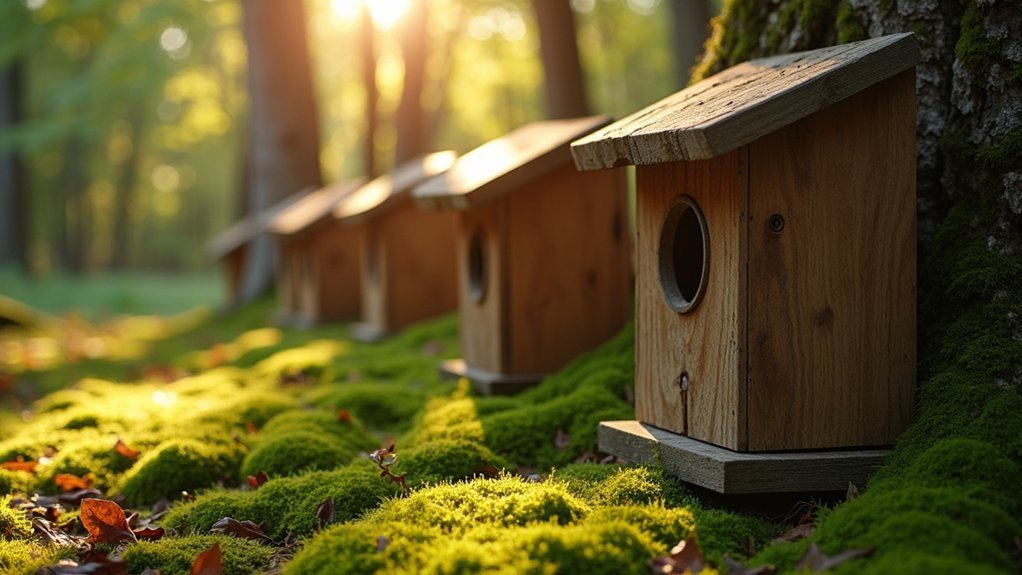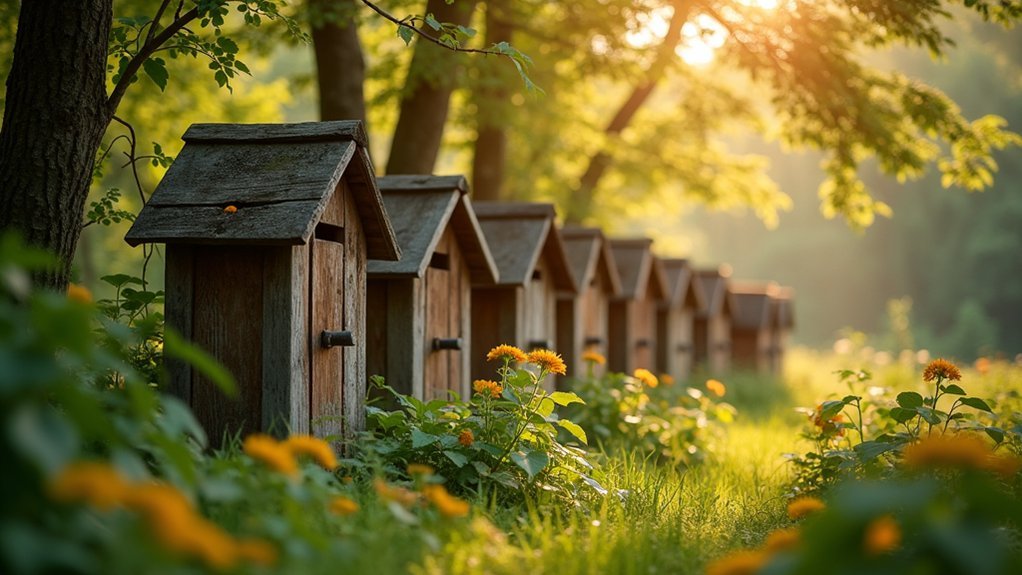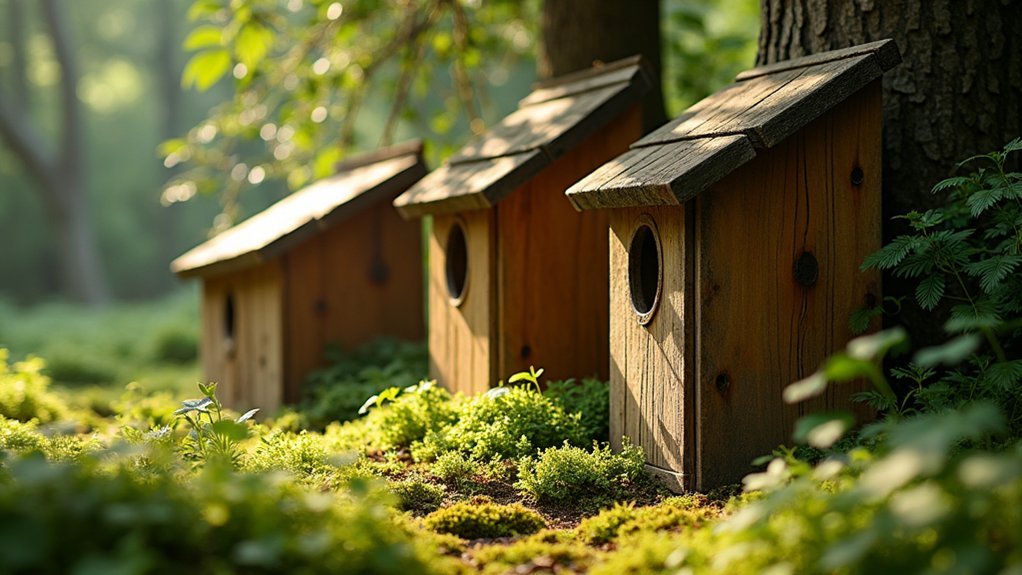The perfect sun exposure for nest boxes is typically an east or north-facing orientation that provides beneficial morning warmth while avoiding harsh afternoon heat. You’ll want to position boxes where they receive some morning sunlight but gain shade as the day progresses. Light-colored or white boxes reflect heat better, keeping interiors up to 8°F cooler. Different bird species have specific preferences, so your local avian residents will influence the ideal placement strategy.
Understanding The Effects Of Sun Exposure On Nest Box Temperatures

When placing nest boxes in your yard, the direction they face can dramatically impact internal temperatures. Boxes positioned toward the north or east minimize exposure to harsh afternoon sun, preventing dangerous overheating that could harm developing nestlings.
Research shows that interior temperatures can exceed outside air by more than 6.3°F, creating potentially fatal conditions for young birds.
Nest box temperatures frequently surpass ambient conditions by over 6.3°F, creating life-threatening environments for vulnerable nestlings.
You’ll want to guarantee your boxes receive afternoon shade, which can make them up to 20 degrees cooler than those in direct sunlight.
Light-colored or white-painted boxes reflect heat efficiently, running up to 8°F cooler than unpainted alternatives.
Don’t overlook proper ventilation—incorporating small gaps and vents allows hot air to escape, preventing heat buildup that could lead to dehydration and developmental issues in nestlings.
Optimal Directional Orientation For Different Bird Species
When setting up nest boxes, you’ll find that different bird species have distinct preferences for morning versus afternoon sun exposure.
Your Carolina Chickadees and Wrens will thrive with north or east-facing boxes that avoid the harsh afternoon heat, while Chestnut-backed Chickadees need eastern exposure in coniferous settings.
For water-loving Hooded Mergansers, you’ll want to position boxes facing south or west near water bodies, balancing adequate sunlight with protection from excessive heat.
Morning vs. Afternoon Sun
The directional orientation of your nest box greatly impacts its internal temperature and overall suitability for nesting birds. North or east-facing boxes capture beneficial morning sun to warm the interior after cool nights while avoiding afternoon heat.
Afternoon shade is vital, potentially keeping your box up to 20 degrees cooler than those in direct sunlight. This temperature regulation creates an ideal nesting habitat for many species, particularly Carolina Wrens and other songbirds that prefer cooler environments.
Position the entrance away from prevailing wind patterns to prevent rain from entering and reduce stress on your feathered tenants.
The ideal setup allows the box to receive gentle morning sun while being protected from intense afternoon heat. This balance guarantees comfortable conditions and lets you monitor nesting activity from a respectful distance.
Species-Specific Direction Preferences
Different bird species have evolved distinct preferences for nest box orientation based on their natural habitat requirements and behavioral adaptations.
When you place your nest boxes, consider that Carolina Chickadees and Hooded Mergansers prefer south or west-facing boxes to capture afternoon warmth, while Bluebirds thrive with east-facing boxes that catch gentle morning sun after cool nights.
Great Crested Flycatchers, however, favor north or east orientations that minimize exposure to intense afternoon heat that can trap hot air inside the box.
Carolina Wrens do best with boxes tilted slightly forward facing south or east, hidden in thick underbrush.
Remember that improper orientation can provide predators access to vulnerable nestlings or create dangerous temperature conditions.
Always match your box direction to the specific needs of your target species.
Balancing Morning Warmth And Afternoon Shade

Finding the perfect balance between morning warmth and afternoon shade is essential for creating an ideal nest box environment. Position your boxes facing north or east to capture the beneficial morning sun that warms the interior after cool nights, supporting proper egg and nestling development.
Proper nest box orientation captures vital morning sunlight while avoiding afternoon heat that can harm developing birds.
While morning sunshine is advantageous, afternoon shade is important for nesting birds. Shaded locations can keep the interior up to 20 degrees cooler than exposed areas, preventing dangerous overheating.
Since nest boxes can become 6.3°F hotter inside than outside air temperatures, this temperature regulation is critical. Install your boxes under tree canopies or near vegetation that blocks intense afternoon sun.
This placement not only manages temperature but also creates a safer environment for fledglings when they leave the nest. A slight forward tilt helps keep rain out.
Strategic Placement To Protect Nestlings From Heat Stress
Strategic placement of nest boxes greatly impacts nestling survival during hot weather.
You’ll need to carefully position your boxes to shield vulnerable chicks from dangerous heat stress that can occur during summer months.
- Face boxes north or east to minimize direct afternoon sun exposure, keeping internal temperatures more stable.
- Seek afternoon shade from trees or buildings to lower internal temperatures by up to 20 degrees.
- Choose light-colored or white boxes that reflect sunlight and reduce temperatures by up to 8°F.
- Position the right box away from prevailing hot afternoon sun while ensuring it’s distant from roads and buildings to help nestlings safely fledge.
These placement strategies create cooler microenvironments that greatly increase nestling survival during heat waves.
Regional Considerations For Nest Box Sun Exposure

While general placement rules apply broadly, your geographic location greatly impacts ideal nest box positioning for proper sun exposure.
If you’re in southern regions, orient your nest boxes north or east to reduce afternoon sun exposure, which can decrease internal temperatures by up to 20 degrees Fahrenheit.
For northern locations, focus on placing boxes in shaded areas or install them with a slight forward tilt to combat summer heat. This is particularly important during the breeding season when nestlings are vulnerable to temperature fluctuations.
In open habitats, maintain 15-25 foot spacing between nest boxes to balance sunlight needs without excessive heat.
Consider installing multiple boxes with varied orientations, giving birds options to select best microhabitat conditions based on your region’s specific climate challenges.
Adapting Nest Box Design For Ideal Temperature Control
Beyond regional placement strategies, the physical design of your nest box dramatically impacts its ability to maintain comfortable temperatures.
Smart design choices can keep internal temperatures comfortable for avian residents even during hot weather.
- Paint your nest boxes white or a light color to reduce temperatures by up to 8°F compared to unpainted boxes.
- Position boxes facing north or east to minimize afternoon sun exposure.
- Create ventilation gaps between the roof and walls that allow hot air to escape.
- Install a sun shield extending beyond the roof to provide additional shade.
Don’t forget to regularly inspect your nest boxes, ensuring ventilation systems remain unclogged and roofs are intact.
These simple design adaptations can make the difference between a comfortable haven and a dangerous heat trap for nesting birds.
Frequently Asked Questions
Where Is the Best Place to Put Bird Nesting Boxes?
Place your bird nesting boxes facing north or east in shaded areas. You’ll protect birds from overheating by avoiding afternoon sun. Make certain there’s a clear flight path away from roads and buildings for fledgling safety.
When Should You Put Nesting Boxes Up?
You should put nesting boxes up by February in southern regions and by mid to late March in northern areas. This gives birds time to discover them before breeding season begins.
Should Bluebird Houses Be in Sun or Shade?
Your bluebird house should get morning sun and afternoon shade. Place it facing north or east to keep nestlings protected from overheating. This balanced exposure provides warmth while preventing temperatures from rising too high.
Where Is the Best Place to Put a Robin Nest Box?
Place your robin nest box in partial shade, facing north or east, at a height of 3-10 feet. You’ll want to guarantee there’s a clear flight path and nearby shrubs for fledgling protection.
In Summary
When mounting your nest boxes, aim for east or northeast orientation to provide beneficial morning sun while avoiding afternoon heat. You’ll need to adapt based on your local climate—more shade in hot regions, more sun in cooler areas. Remember, you’re creating a microclimate that keeps nestlings safe through temperature extremes. The perfect placement balances sunlight, shade, and regional factors for each bird species.





Leave a Reply